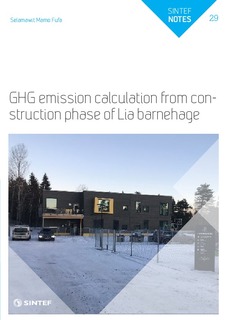| dc.description.abstract | This report summarises the life cycle assessment methodology used to calculate the GHG emissions from a case study considered under "Utslippsfrie byggeplasser forprosjekt". The greenhouse gas emissions (GHG emissions) of Lia barnehage were calculated based on the Life Cycle Assessment (LCA) methodology. The aim was to analyse and document construction phase emissions. A functional unit of 1 m2 of heated floor area over an estimated building lifetime of 60 years is considered. The total heated floor area is 1600m2. Construction site activities considered include transport of building materials, construction machinery, energy use, temporary works, waste management and person transport. The environmental performance is calculated in terms of GHG emissions weighted as carbon dioxide equivalents (CO2eq) according to the IPCC GWP 100-year method.
The GHG construction emission results are 1,19 kgCO2eq/m2/yr, 1970 kgCO2eq/yr, 72 kgCO2eq/m2 over a 60-year lifetime and 114 413 kgCO2eq in total. The largest contributor to GHG emissions from the construction site is transport of building materials (46% or 0.55 kgCO2eq/m2/yr). This is followed by construction machinery (34% or 0.40 kgCO2eq/m2/yr), person transport (10% or 0.11 kgCO2eq/m2/yr), construction waste (7% or 0.08 kgCO2eq/m2/yr), energy use (3% or 0.04 kgCO2eq/m2/yr), and temporary works (1% or 0.01 kgCO2eq/m2/yr). In Lia barnehage, use of biodiesel in construction machineries was considered as one emission reduction measure. During the construction period, biodiesel was used in all machineries except the Crane. A Sensitivity analysis was performed to evaluate the emission reduction from construction machinery fuel use considering four potential alternative fuel scenarios. One worst case scenario (use of diesel only) and three best case scenarios (use of biodiesel only and electricity only for two different emission factors for electricity) are considered. The results show that the use of biodiesel in Lia barnehage in place of diesel for excavators, loaders, drills and vibroplate machineries enabled to reduce the emission from the construction site by 13%. The GHG emission from the construction site would have been further reduced by 4% if biodiesel was also used for the cranes and by up to 13 % (using the Norwegian ZEB centre emission factor for electricity) to 27% (using the Ecoinvent v.3.1 database, system model "Electricity, low voltage {NO}| market for | Alloc Rec, S" emission factor for electricity) if electricity was used as fuel source for all machineries.
Experiences from data collection show that the quality of the inventory and background data source used can greatly affect GHG construction emission calculations. It is recommended to develop a construction site life cycle inventory database with emission factors for common construction site activities. The laborious process of data collection in this study, has also highlighted the importance of using data collection sheet at the early project phase to simplify the construction site data collection process, and improve data quality and transparency. This study also highlighted the importance of performing LCA at the early design phase to evaluate, plan and compare GHG emission reduction measures. Including the cradle to grave LCA of the building using different indicators will enable to avoid problem shifting from one life cycle stage and/or environmental indicator to another. A sensitivity analysis is one method used to evaluate impact of emission reduction measures and their sensitivity to variation and uncertainty factors in LCA. It is recommended to develop a methodology to incorporate sensitivity analysis to evaluate emission reduction measures, inventory and emission data quality. The results from this study may be used in future Norwegian construction projects as a reference, to help measure, evaluate and compare the environmental performance of construction activities. Further study is required to collect case studies of different building typologies to gain experience in evaluating and minimising the potential environmental impacts from other types of construction sites. | |
